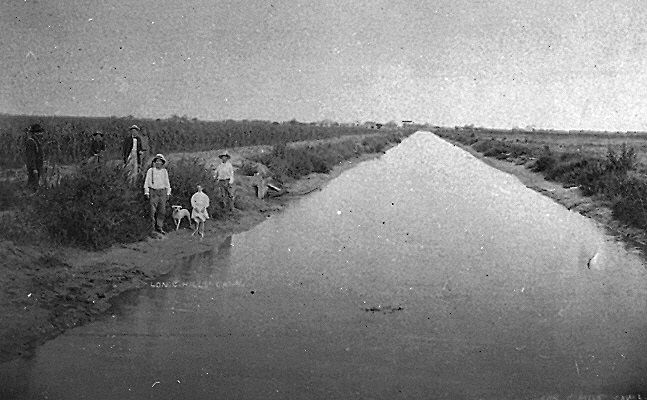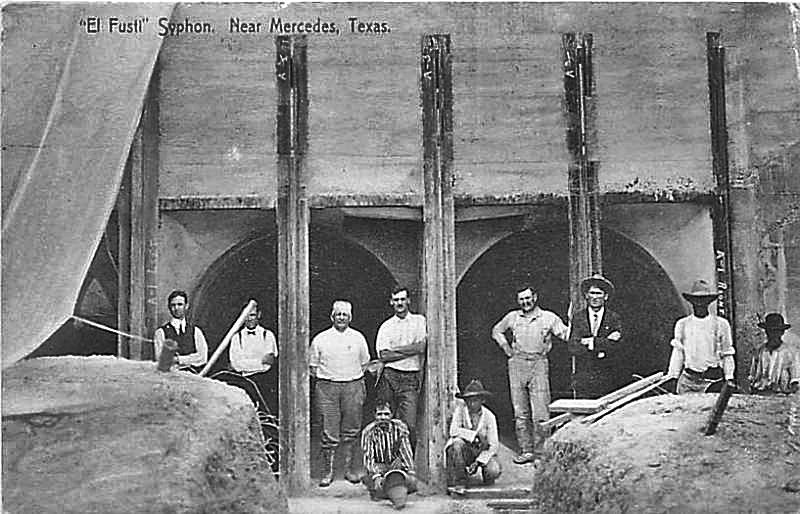BY NORMAN ROZEFF
EDITOR’S NOTE: This is the third part in an ongoing series on Sam Robertson. The other parts can be found at www.valleystar.com.
As the line from Robstown to Brownsville neared completion, more and more people badgered Robertson to take them and their goods to the Valley. Perhaps they sensed the opportunities and wished to get in on the “ground floor”.
In any event, the Johnston brothers discouraged such hitchhikers. Sam, however, could always use the extra income and allowed the smuggling, if you could call it that. In fact, the first item of commercial freight over the line occurred when the line reached Lyford in March 1904.
Sugar refiner John Closner of San Juan Plantation had purchased sugar factory machinery from the state farm in Fort Bend. When the three carloads reached Lyford, Closner then hauled the bulky machinery cross-country in ox carts.
A well-documented labor problem occurred as the line neared Combes. The surfacing gang walked off the job when its wages were cut from $1.50 to $1.25 a day. Their absence was quickly filled by new recruits from south of the border. There was a problem though; they didn’t want to be paid in US currency. They wanted pesos. A compromise was reached that the worker found acceptable. They were paid in chits redeemable from the Henry E. Field store in Brownsville. Field was the son of the famous civil engineer Matthew Dickerson Field and the nephew of the renowned Cyrus Field, layer of the trans-Atlantic cable.
The laborers were familiar with these chits, and they were even accepted on both sides of the border as currency by local establishments.
One of the oft repeated stories involved Mrs. Donna Hooks Fletcher of Donna. Upon receiving word of a sick relative in Beaumont, she wished to travel there but not by the slow and bumpy stagecoach nor was a Morgan Line ship scheduled soon at Point Isabel. She contacted Sam and convinced him to make her an exception.
The line had reached Barreda, just south of San Benito. Mrs. Fletcher turned up there early on a Sunday morning. She had to wait all day before the swing train would return to Robstown.
Sam placed her in an empty boxcar but provided a bucket of ice water, a few sandwiches, a wire cut mattress and a pillow. He then padlocked her in as protection against anyone with evil intent. She arrived safely in Robstown the next morning, none the worse for wear, and continued her journey to Beaumont via Corpus Christi.
The first consignments into Brownsville were two pianos destined to J. B. Sterns and brought in on March 10, 1904, fully three months before the official opening of the route to Brownsville. J. B. Weller, who would come to own a series of saloons in Harlingen and then rise to become the town’s first banker, brought down his belongings on a swing train and had them dropped unceremoniously in the brush.
A Houston lumber dealer also inveigled what would be the first lumber load ever shipped to the Valley by rail. Robinson even set up a tariff table at the time. A car with any type of contents would be charged $30 to go between Robstown and Kingsville and $50 between Robstown and Brownsville. One way fare between Robstown and Brownsville was $10 for a passenger. Passengers rode in the old reliable caboose nicknamed “Loblolly”.
At one point during the construction Sam would act out a scene straight out of a movie. He was riding his horse outside of Harlingen when he spotted a loaded run-a-way flatcar.
Galloping along side he jumped on the car and managed to set its hand brake to stop the car. If Robertson had not done so the train would have crashed into the camp of the concrete gang just ahead and the campsite occupied by the George E. Badger family. Sam never publicized his heroic action.
On the occasion of Lon C. Hill’s 70th Birthday Celebration on July 21, 1932 Robertson himself recounted his first meeting with Lon C. Hill, who would become the founder of Harlingen. He relates in Javalina Hog on Menu:
“In May 1904, I was laying the track and building the bridges of the St. Louis-Brownsville and Mexico R.R., now Missouri Pacific from Robstown to Brownsville. When the point of steel reached Stillman’s ranch we sent a bridge crew ahead to build a temporary trestle over the Arroyo Colorado. Three days later, when the point of steel had reached Chas. Combes ranch, I mounted my white horse, Caballo Blanco, to go ahead to the Arroyo to inspect the bridge work. At the time I was on crutches with a broken leg and old Caballo Blanco would lay down so I could get aboard.
As I rode along the new made grade south of Combes two big bull Mexican lions dashed across the grade one chasing the other; three or four droves of wild deer scampered across the right of way. About where the Southern Pacific R.R. Now crosses the Missouri Pacific, a herd of Javalina hogs had a drove of wild turkeys on the run. When I got up to about where the old frame depot of the Missouri Pacific now is, I noticed a bunch of Mexicans, clearing a plot of land about 30 acres in extent. I noticed a canvas fly, buckboard horses, and some Americans around a camp fire. I rode over to this camp and met Lon C, Hill, Sr. for the first time, Gordon his son, a youth of about 17, Mose, John, and Nick, his young sons.
Had No Tents Their camp was about 200 feet north of where Reese-Wil-Mond Hotel now stands. They had no tents, only a fly, no cots, bedrolls were on the ground, saddles for pillows. They had rolled in two barrels of water from the Rio Grande. Lon was supervising two or three Mexican servants in the preparation of “stew”, a leg of venison being barbecued on the coals, young Javalina pig was stewing in an earthen pot, Mexicans were making tortillas and roasting sweet potatoes and green corn in ashes. A drove of chachalacas (Mexican pheasants) were sounding off in a nearby mesquite as coyotes howled and fought over the offal of a deer, Gordon had just shot, and dressed in the jungle, only a few hundred feet away.
When I rode up on old “Caballo Blanco” Lon invited me to “light” and have coffee. Introductions followed to his boys. My horse was tired and very dry. Mose (Lon C. Jr.) made a lifelong friend of me by stealing from the cook a half-bucket of water which was scarce as hen’s teeth, to give to my dear friend, Caballo Blanco.
Plans For City As we drank coffee, Lon explained to me his plans for building a great city on the land, the center to be about where they were now sitting cross-legged on the ground. He explained how he would build canals to bring in water from the river, put out great sugar plantations and build sugar mills and other industries to support the proposed city. And he carried on his improvements campaign as long as he could raise a dollar, and he raised more than a million of them. At that time he owned 25,000 acres of land reaching from the Rio Grande out to the Arroyo and beyond Harlingen several miles, 45,000 acres running from the Rio Grande 16 miles including the present townsite of Mercedes. The original townsite of Mercedes was started as Lonsboro, one and a half mile east of where Mercedes now stands.
He had over 30,000 acres west of Raymondville, a big rice plantation at Rincone (sic), north of Brownsville, a cotton plantation in the Tully Lake bed not far from his rice plantation. His wife and young daughters lived in Brownsville; no finer, more refined or better ladies ever lived than the women of this household. Lon and his boys were full of idealism to make many blades of sugar cane and other crops grow where none were growing. The jungle covered the townsite and the whole country was infested with ticks, peniles, fleas by the billions, rattlesnakes and scorpions, and other pests in countless millions.
Rattle Snake Junction My construction and train men soon christened Lon’s future city Rattle Snake Junction. At his time there was not a house in sight of the R.R. right of way from Robstown to Olmito and from Rattle Snake Junction to Havana, three miles east of Sam Fordyce.
A few days after my first visit to Lon’s camp we reached the Arroyo Colorado with the point of steel and we were held up a few days on account of finishing the bridge over the Arroyo. At this time Mr. B. F. Yoakum, Col. Lott, Ben Johnson, Col. Sam Fordyce, Tom West and Mr. Breckings and others of the Construction Syndicate, who were financing the R.R., came down from St. Louis on a special train of about eight or ten special cars of eastern capitalists including W. K. Vanderbilt. Lon took Mr. Yoakum and other capitalists on a number of buckboards drawn by four mules each, fording the Arroyo Colorado and winding through the jungle striking the Military road about where Los Indios now is and on to Brownsville, a drive as it was necessary to travel of about 50 miles. The result of this trip was the financing of the Hidalgo branch to Sam Fordyce.
Donated Property Lon gave thousands of acres of his property to the construction syndicate to make possible the construction of both main line and Hidalgo branch. Had it not been for the liberality of Lon Hill, John Closner, and Tom Hooks, the Hidalgo branch construction would have been delayed many years.
In 1906 Lon started the construction in a small way of the Harlingen Canal, and I, having obtained in 1904 an option from James Landrum and Oliver Hicks on the 12,000 acres surrounding Bessie, now San Benito, started the construction of the San Benito canal in Dec. 1906 and was joined by Haywood Bros. and others in 1907.”






